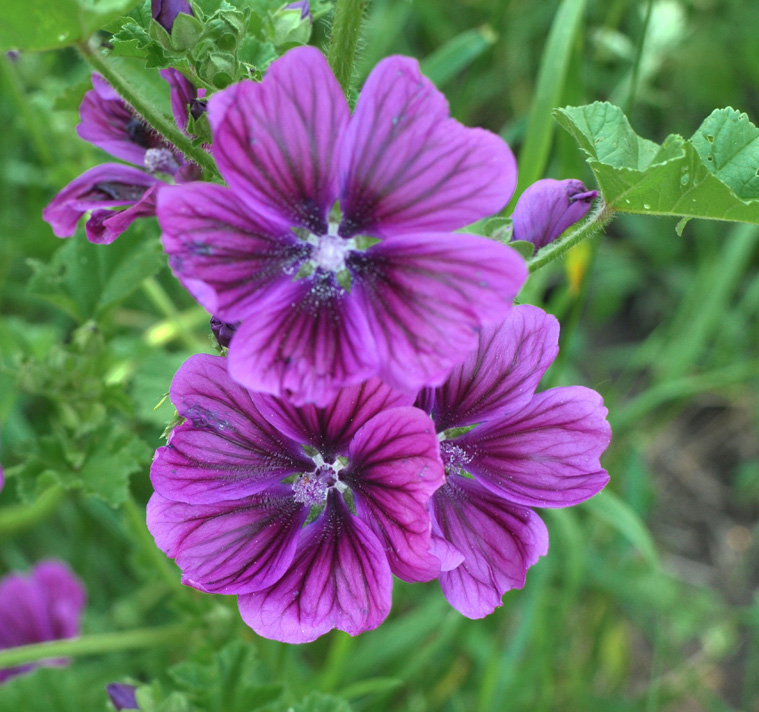- 1-9 pkts $4.50
- 10 pkts FREE
- Express post $12
Malva sylvestris ssp. mauritiana ‘Bibor Felho’
PURPLE CLOUD FRENCH HOLLYHOCK
Malva sylvestris ssp. mauritiana ‘Bibor Felho’ creates a cloud of purple.
Not permitted for entry to WA.
‘Bibor Felho’ means Purple Cloud
‘Bibor Felho’ means “Purple Cloud” in Hungarian, and the name describes it well.
Velvety purple flowers striped with deep purple
With velvety royal-purple flowers boldly striped with deep purple veins, emerging from rich purple buds.
So the whole plant is a symphony of purple when in bloom.
The large flowers are shaped like saucers, filled with lush colour.
Set off by velvety grey-green leaves
Rich purple flowers and grey-green velvet textured foliage, make an elegant combination.
With the flowers shining royally against the cool foliage.
Elegant & refined looks, but tough & hardy as old boots
Malva sylvestris ssp. mauritiana ‘Bibor Felho’ is actually as tough as old boots, despite the regal good looks.
So it has always been a popular, easy to grow, low maintenance, old favourite cottage perennial. Because of its tough constitution, useful edible flowers and foliage, and companion plant qualities.
Showy flower spires through summer & autumn
Blooms are stacked upon 1.2m. tall flower spires.
So many people mistake it for some sort of unusual, particularly velvety Hollyhock.
Like unusual striped Hollyhocks – But a smaller & neater
Indeed the whole plant does look and behave like a well mannered Hollyhock.
And the French claim it as their Hollyhock.
But Malva sylvestris ssp. mauritiana ‘Bibor Felho’ is equally hardy, tough, and easy to grow, as any Hollyhock.
And equally spectacular in bloom as any Hollyhock – with those amazing royal purple velvet flowers.
Self supporting & not prone to blowing over
So this is the fake Hollyhock everyone can have, even in windy and exposed sites.
The branching flower spires do not usually need staking, unless they are over-fed.
‘Bibor Felho’ performs much better on a lean diet.
Cut spires for floristry
Cut stems of Malva sylvestris ssp. mauritiana ‘Bibor Felho’ are excellent for vases – they last well when cut, and are certainly very eye-catching in colour and texture for arrangements.
Edible flowers & foliage
The plant is also a boon for cooks.
Because both the flowers and foliage are edible.
Use as a savoury vegetable
Toss tender young leaves into salads, and cook older leaves like Spinach (delicious with pine nuts & melted butter), or cook with tomatoes and onions, dress pasta, or use them in soups and casseroles.
Malva sylvestris ssp. mauritiana is often used in traditional Mediterranean country cuisine as a thickener for soups.
Or in herbal teas & drinks
While the flowers are used to make herbal teas, traditionally believed to have anti-inflammatory benefits.
Or the leaves used to make anti-inflammatory poultices.
The seeds are also eaten raw or roasted as a healthy snack.
And the flowers and foliage have long been used to distill liquors.
In some regions around the Mediterranean the tea or liquor is also regarded as an aphrodisiac.
For dye & papermaking
While the foliage and flowers are traditional dye plants and used for paper-making.
This is the plant that just keeps on being useful.
Nectar feast for bees & pollinators
The nectar rich striped blooms also drag the useful pollinators into your garden, and keep them there with such a long blooming season.
Traditional companion plant for fruit & vegetables
So it has always been a traditional companion plant for vegetable and fruit gardens.
Rabbit & deer resistant
Happily rabbits and deer do not like the taste of French Musk Mallows, unlike we humans.
Care free & low maintenance
Malva sylvestris ssp. mauritiana ‘Bibor Felho’ is blissfully carefree to grow, and untroubled by any pests and diseases of consequence.
As long as it is planted in full sun, or just a little shade if you need (it will become lanky in too much shade).
Highly tolerant of air pollution & poor soils
It is also highly tolerant of urban air pollution.
And copes well with soils of low fertility, and of a wide pH range from acid to alkaline; sandy, gravel or loam soils; as long as the soil is well drained.
Frost hardy
Malva sylvestris ssp. mauritiana ‘Bibor Felho’ is undaunted by frosts and well able to tolerate temperatures down to -20°C.
Heat hardy
Similarly it is able to tolerate summer heat, as it is native to areas of extreme temperature ranges, such as northern Africa.
Water-wise & drought resistant
It is a water-wise plant, needing very little additional watering to cope with dry seasons.
Low maintenance
While the French Hollyhock ‘Bibor Felho’ can survive quite well without any help from a brown-thumbed gardener.
She will repay a chop back of spent flower stems in late summer, by shooting back very quickly with another abundant crop of flower spires for autumn.
Cut back hard to ground in winter to make room for wonderful new growth in spring and another year of flower spires.
Hardy perennial
1.2m. tall when in flower spires x 60cm. wide clump of velvety grey-green foliage.
SEED SOWING ADVICE: QUICK & EASY
Suitable for beginners & gardening with kids
Seeds of Malva sylvestris ssp. mauritiana ‘Bibor Felho’ can be sown in spring or autumn,
or at any time indoors when suitable temperatures can be provided (18-22°C).
OR
Scattered directly in the garden in autumn, late winter or early spring.
Sow Indoors for early plants: Sow the seeds in a punnet on the surface of good quality seed raising mix.
Now gently pat the seeds to the surface to ensure good contact.
Then lightly cover with mix or fine sandy grit.
You can now just keep them warm and moist and wait for nature to take its course, but there is a Tip to get things happening more quickly.
Tip for improving germination rates & speed: Seeds of Malva sylvestris ssp. mauritiana ‘Bobor Felho’ have a much better germination rate and speed, if they are pre-conditioned with a period of warm-cold first.
So thoroughly moisten the sown punnet by standing it in a shallow water bath.
And allowing the moisture to percolate up to the surface of the mix from below.
Then place punnet in a warm, well-lit position (not in any direct sunlight) for 2-4 weeks.
Temperatures of 18-22°C approx. are best for this warm pre-conditioning period (or you can just keep them here till they begin to germinate).
You can use a heat mat if you have one, but it is not essential.
The seeds often germinate at this stage without further treatment.
But if they are shy to germinate – then give them a pretend winter.
A pretend winter
So after the period of warm, wrap the moist, sown punnet in cling-wrap or a plastic bag and place in the fridge (not freezer) for 4-6 weeks.
Then remove and return to the warm, well lit position (not in any direct sunlight) at 18-22°C.
Continue to keep consistently moist by misting regularly from a spray water-bottle.
Placing a plastic lid or bag over the sown punnet will also help to maintain consistent moisture.
Remove cover as soon as germination has commenced.
Seedlings emerge in approx. 14-21 days.
Scatter seeds directly in the garden:
Scatter in a full sun position in soil that drains well and rake in gently.|
Continue to keep consistently moist for germination.
Scatter seeds directly in the garden:
Scatter in a full sun position in soil that drains well and rake in gently.|
Continue to keep consistently moist for germination.
Seed Count: 10 seeds per pack approx.
(We always aim to exceed the stated seed count and give a generous serve).
Click here for Nursery Open Days & Open Gardens Information
https://www.gardivalia.com.au/open-gardens
Click here to go back to Seeds Shop
https://www.seedscape.net.au/shop/
Related products
-
Add to WishlistAlready In WishlistAdd to Wishlist
-
Add to WishlistAlready In WishlistAdd to Wishlist
-
Add to WishlistAlready In WishlistAdd to Wishlist
-
Add to WishlistAlready In WishlistAdd to Wishlist





